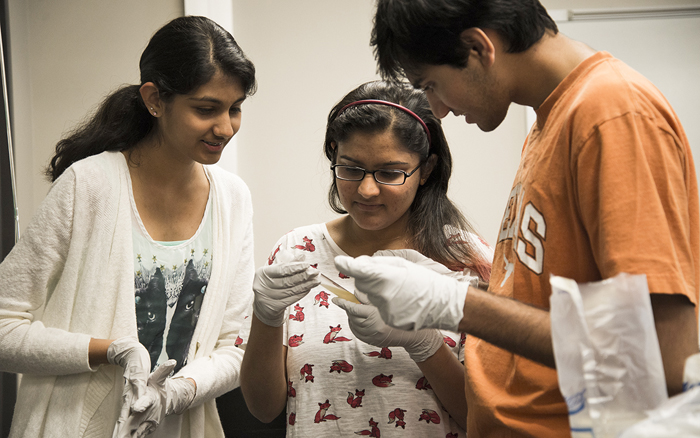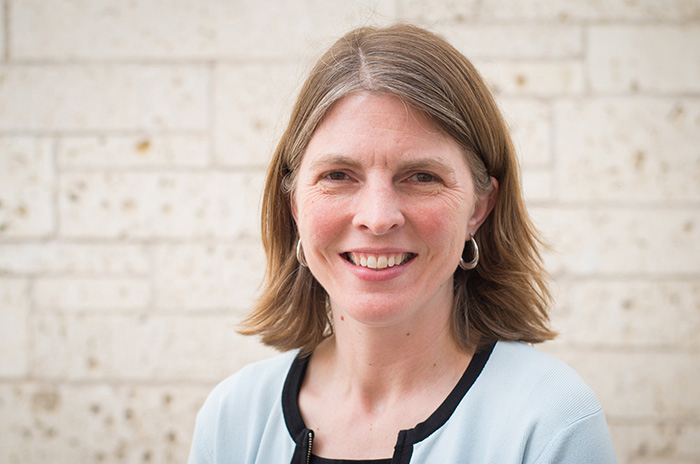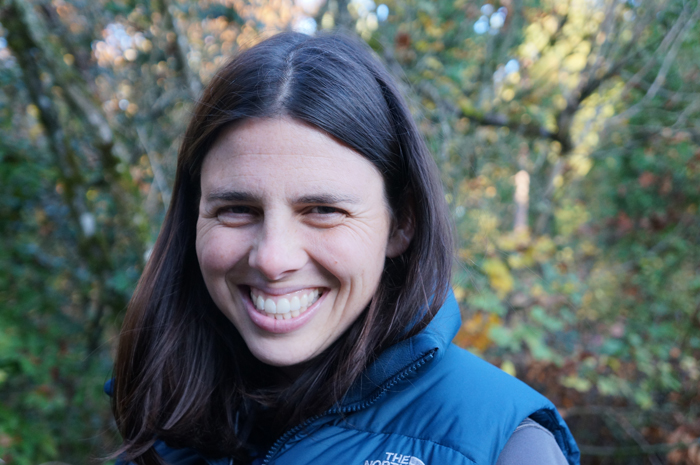Not even a year old, the Texas Institute for Discovery Education in Science is opening its doors this summer to spread a message beyond the 40 acres about teaching through discovery.
From high school students to visiting scholars to faculty from other universities, people are coming to the College of Natural Sciences and TIDES to learn more about the power of experiential learning, for which the college is nationally known.
TIDES launched in August and is perhaps best known as home to the Freshman Research Initiative, a premiere program that is being replicated across the country. Other experiential learning programs in the College also find a base at TIDES, as do faculty-focused workshops and consulting on teaching, and evaluation of educational initiatives. In the summer, however, TIDES also looks outward, offering programs for high-schoolers, as well as faculty from other institutions.
We share some highlights of what TIDES is up to during its first summer on campus.
 |
| High school students collaborate during a Research Methods class. Photo by Jeff Mertz. |
CURE Summer Institute
 |
| Erin Dolan |
Involving students in research early has a measurable impact on the success of students in the sciences. In FRI, first-year students have the opportunity to participate in cutting-edge research alongside UT faculty. FRI is one example of a Course-Based Undergraduate Research Experience, or CURE—which happens to be the topic of a TIDES-hosted event next week.
The CURE Summer Institute is the first national workshop for educators who want to develop their own courses to integrate research into their curriculum. The summer institute is funded in large part by the National Science Foundation’s sponsorship of CUREnet, a UT Austin-led network of faculty developing and teaching CUREs.
Educators from sixteen colleges and universities across the nation will be attending the institute. The participants represent a diverse array of institutions, including two-year colleges, four-year colleges and research universities.
“The CURE Summer Institute is for faculty who want to integrate research projects into existing one-semester or one-quarter lab courses, rather than the full three-semester sequence,” said Erin Dolan, Director of TIDES, referring to the sequence that FRI follows. “In addition, because the CURE Summer Institute is being aligned with the National Academies’ Summer Institute model, there will be a focus on backward design—specifically, how to design a course with integrated research and teaching goals.”
Interest in the Summer Institute has been enormous. TIDES received twice as many applications as it had available spots and continues to receive inquiries about openings.
Participants in the Summer Institute will learn about and use evidence-based strategies and the latest techniques to develop and design their own CURE. They will then unveil and teach this new course at their home institutions during the upcoming 2015-2016 academic year.
The Scholar-in-Residence
 |
| Sara Brownell |
One of the experts in attendance at the Summer Institute will be Sara Brownell, TIDES’ inaugural Scholar-in-Residence. Brownell is an assistant professor of biology education at Arizona State University.
“I study the impact of course-based research experiences on faculty and students,” said Brownell. “I am particularly interested in how CUREs can broaden the opportunities for undergraduates to engage in research to hopefully lead to a more diverse scientific community.”
Brownell’s interest in biology education began as a graduate student at Stanford University, where the department first began to transform its own laboratory courses into CUREs. She had the opportunity to help design, assess and eventually teach the new courses, giving her a unique and complete perspective on the process.
In addition to helping facilitate the Summer Institute, Brownell will be giving a number of talks and workshops over the next few weeks to educators at UT Austin. One talk will be given at the Institute, where she will discuss how CUREs are not only valuable for the students, but also benefit faculty.
“While I think student outcomes are really important, I think one of the really fantastic things about CUREs is that faculty can get something out of it,” said Brownell. “Faculty are getting pilot data, they’re potentially getting research publications out of it. Some of them are getting a chance to do teaching that is more meaningful for them than typical lecture teaching.”
The Summer High School Research Academy
While the focus of the Summer Institute is on creating courses for undergraduates, participants will have the chance to learn about another TIDES initiative, which takes the idea of CUREs to local high schoolers. The Summer High School Research Academy is a program that allows high school seniors, juniors, and the occasional sophomore to spend up to five weeks at UT Austin participating in cutting-edge research.
Depending on their experience, students participate in one of two programs: Research Methods or Research Academy.
Research Methods is designed for students with no experience in the lab. They are introduced to the process of doing science and learn how to design experiments, collect and analyze data, and present and evaluate their results.
Stuart Reichler, the program coordinator, noted that many students come in excited about science, but with little idea of which area of science they want to pursue or even what being a scientist looks like. He brings in Research Educators from different disciplines and has them conduct a hands-on activity and talk with the students.
The main event is when the students get to choose and design their own scientific inquiry project. They can do anything, as long as it can be completed in time, is safe, and is within the course budget.
“We try to make it as open as possible to have them push themselves and think 'How creative can I be?'” said Reichler. “So much of education is telling the students, 'Today you’re going to learn this.' Now they get a chance to choose what they’re going to do.”
Students who complete Research Methods can return the following summer and participate in the Research Academy, where they are placed in a faculty member’s laboratory.
These students participate in many facets of research and even have the potential to be published in scientific journals, a rare opportunity for high-school students. In 2013, two students from the program, Cameron Darwin and Viraj Mehta, accomplished this, acting as co-first authors on a journal article with their faculty mentor, Greg Clark, a research scientist in Molecular Biosciences. Clark also is the lead on another TIDES summer program for secondary students, Shadow a Scientist, which pairs middle schoolers with research scientists for a day.
As TIDES inspires and educates students like Darwin, Mehta, and the other visitors to campus, it also teaches others entrusted with educating a new generation of scientists how to do the same. To learn more about TIDES’ offerings, visit http://cns.utexas.edu/TIDES.

















Comments